|
|
Post by Lee Martin on Apr 19, 2018 20:02:01 GMT -5
And as I've mentioned on the Ruger Forum; "I want a mold!" Contender - Dan @ Mountain Molds doesn't require group buys or minimum orders. Just take the specs I posted on page 1, enter them into his online program, and hit the buy button. You'll have it in no time. -Lee www.singleactions.com"Chasing perfection five shots at a time" |
|
|
|
Post by Lee Martin on Apr 19, 2018 20:02:56 GMT -5
Bradshaw Report #2 _____________________________________ Bradshaw-Martin Maximum 194 SWC GC dropped into cylinder; stops in EXIT HOLE (aka THROAT).  Federal send Bradshaw Bradshaw .357 Maximum in 1.545” nickel plated brass. By this time, Remington has started making Ruger’s 1.605” case, but deliveries to Ruger were slow. David and Bill, Jr., shot this experimental ammo, which Federal loaded with the Sierra 170 FMJ. Stiff extraction, accuracy below par. After the fact, Hugh Reed of Federal called Bradshaw to warn, “We pressure tested it, and it’s running 77,000 psi.” Didn’t do diddly to the revolvers. 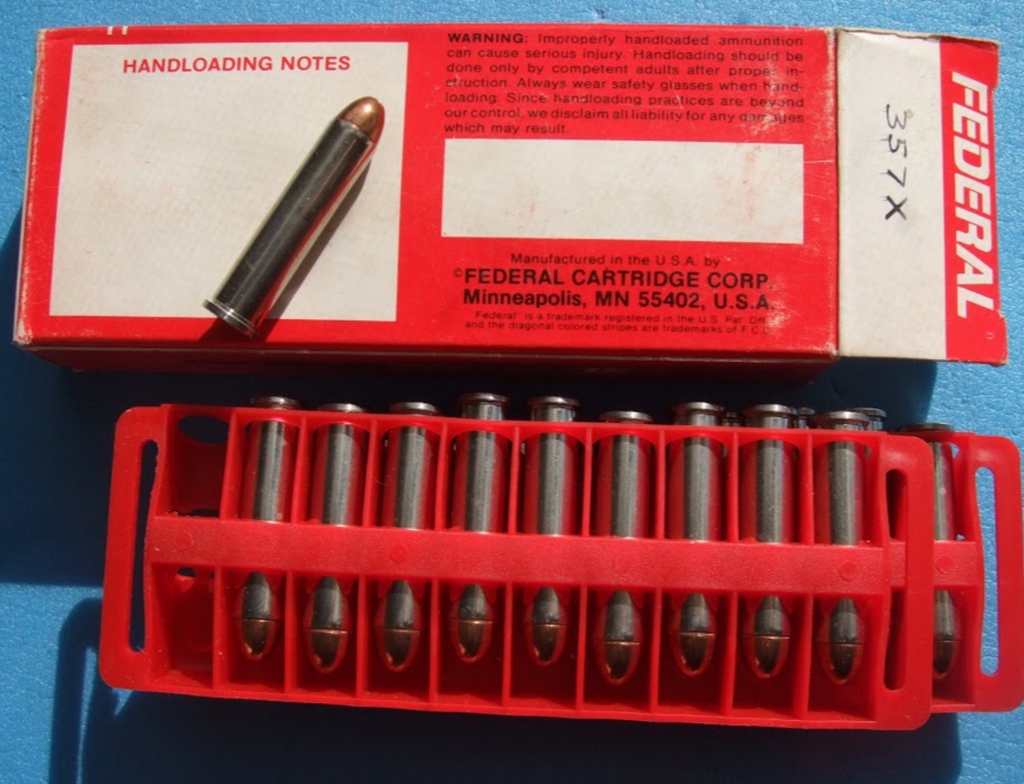 FC headstamp “IHMSA 357 MAX” with ram. Ordered by Elgin Gates for sale through the monthly publication, The Silhouette.  Target blade, .131” wide, on 10-1/2” Maximum. Sight held by screw, easily changed. 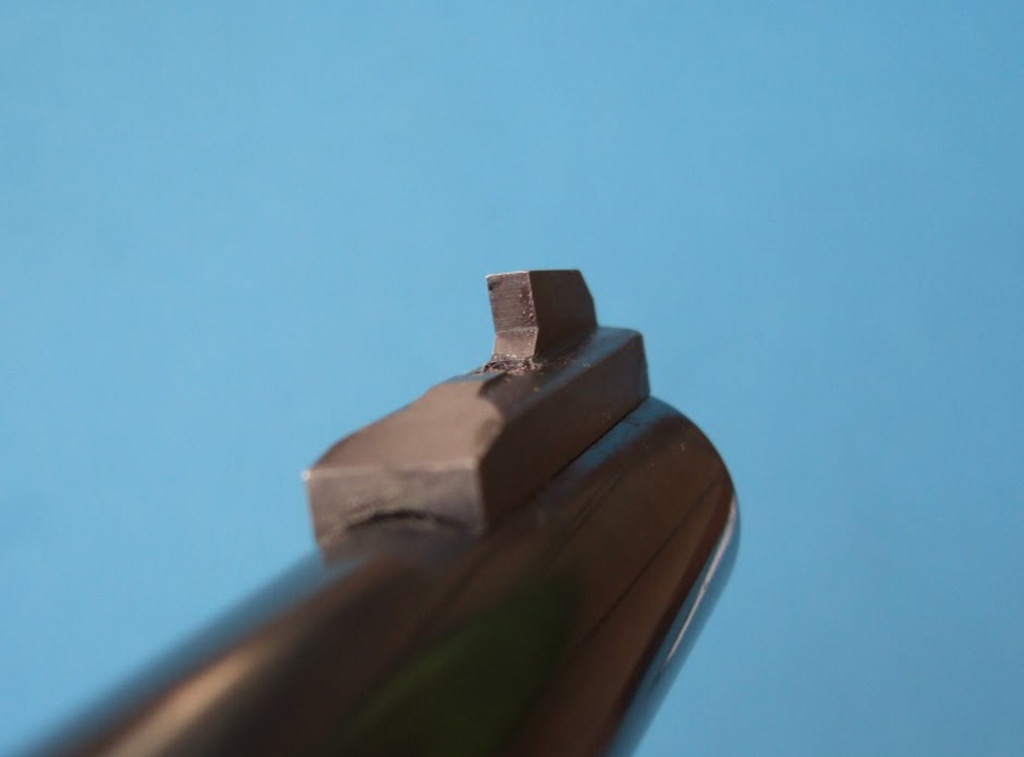 Rear sight with narrow, .091-inch notch, for use with .107-inch front sight. Notch is .055-inch deep. Notch dimensions may vary .005” between examples. Notch on this setups .016 thinner than front sight.  Ruger sight elevated 48-clicks for 200 yards. Elevation screw has 16-clicks per rev; thus, sight is 3-turns above BOTTOM DETENT. 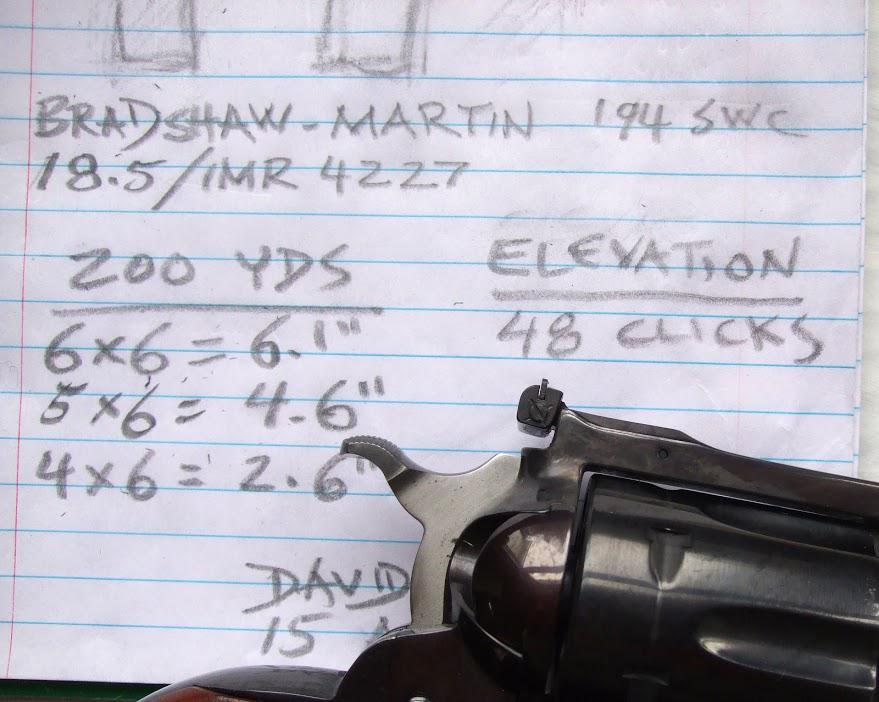 200 yard sight setting w/194 gr Bradshaw-Martin SWC  Notebook record of six shots @ 200 yards. 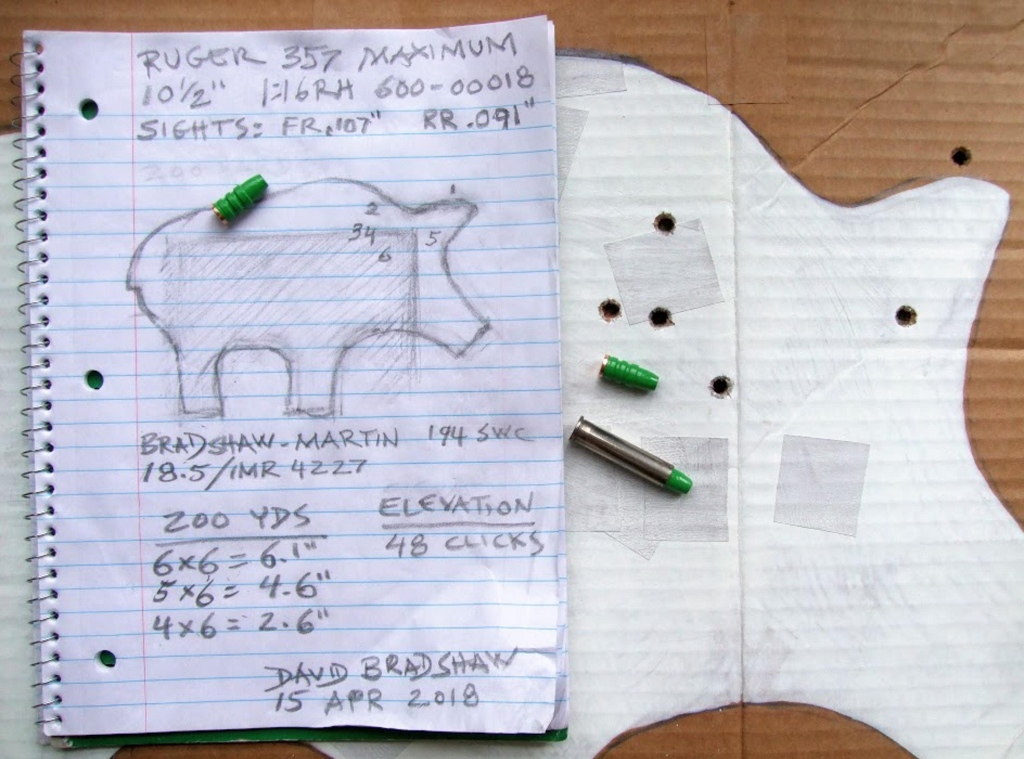 Abrasion of powder coat appears related to punching through plywood and skimming ground below snow. Snow almost certainly responsible for slowing and preserving bullet. Answers David and Lee's question as to whether gas check would be remain attached to heal (underside of the bullet shown a few posts ago)  -Lee www.singleactions.com"Chasing perfection five shots at a time" |
|
|
|
Post by Lee Martin on Apr 19, 2018 20:05:59 GMT -5
Martin Shooting Session #2 ___________________________________ The 194 gr Bradshaw-Martin’s second outing was 2/24. Due to stiff rain, I wasn't able to chronograph. Two loads were assessed. First was my attempt to confirm accuracy with 17.0 of IMR 4227. Once again, 4” groups @ 100 were the norm. 17.0 IMR 4227: 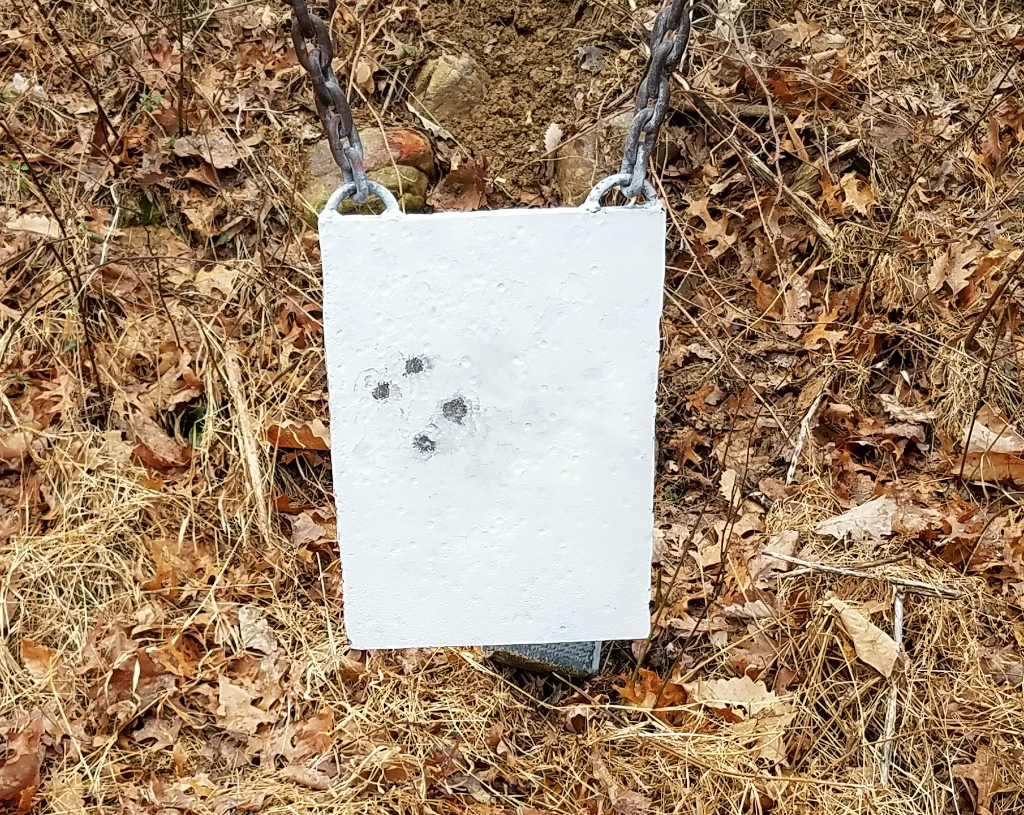  I then tried 18.0 grs of AA1680. The minute the charge lit, I knew it was too light. Even so, they patterned well at 100 paces. 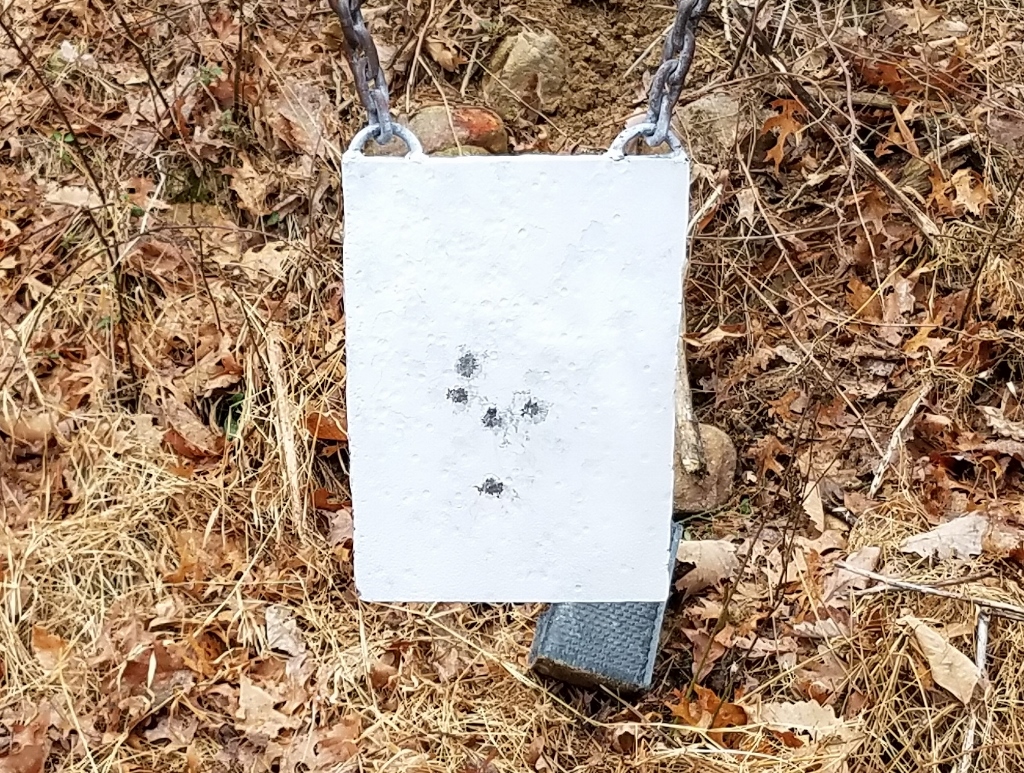 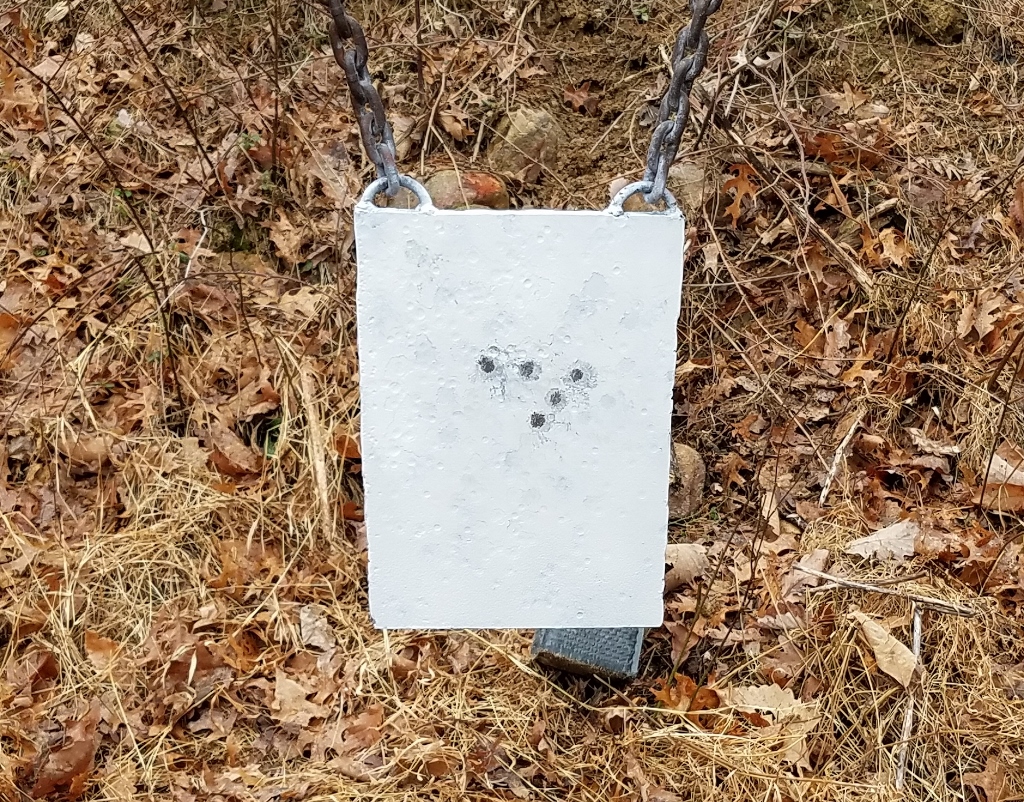 Wind flags, or anything that’ll capture air shifts, are a must for precision shooting. All of the aforementioned targets were shot over flags positioned at 25, 50, and 75 yards. I could not come close to these size groups without them. -Lee www.singleactions.com"Chasing perfection five shots at a time" |
|
|
|
Post by Lee Martin on Apr 19, 2018 20:08:10 GMT -5
Martin Shooting Session #3 _____________________________________ On March 16th, five powders were chronographed under the 194 gr Bradshaw-Martin SWC:  The results (average of 5 shots) • 18.5 grs IMR 4227 = 1,480 fps • 14.5 grs 2400 = 1,434 fps • 22.0 grs AA1680 = 1,432 fps (duplicates the 2400 load - needs more powder) • 22.0 grs AA5744 = 1,671 fps (much faster than expected) • 22.0 grs H110 = 1,794 fps The H110 load moved me to photograph the screen as proof. For comparison, below is the readout for 18.5 grs IMR 4227 (1,464 fps). Still questioning the results, I fired my .41 Magnum with 240 gr casts through the traps. They went 980 as expected. The H110 speed wasn't a fluke. 22.0 grs H110:  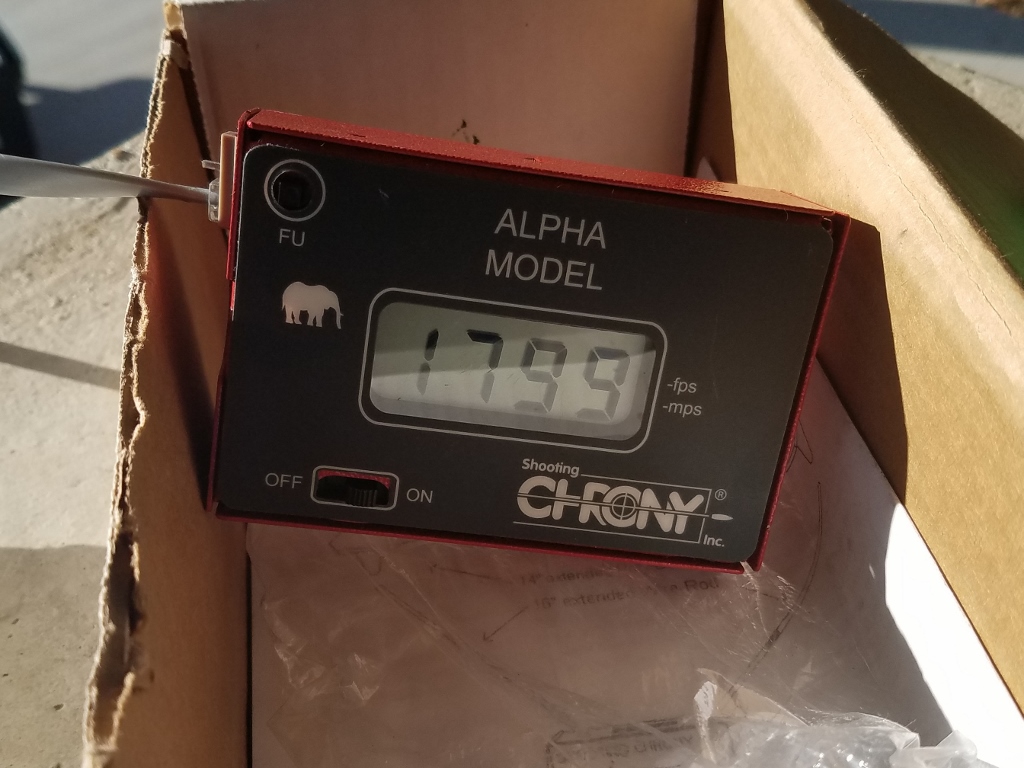 18.5 grs IMR 4227 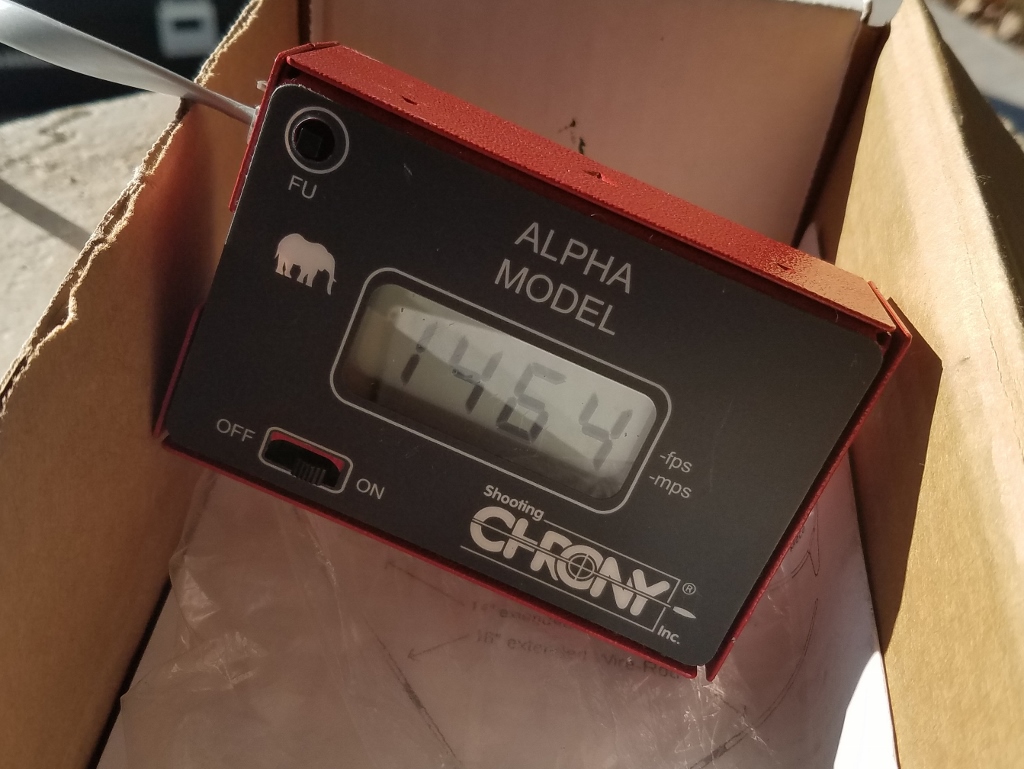 Accuracy results: • H110 was erratic. I had a hard time keeping all 5 on the steel. • 2400 was mediocre. My best group was 9" • AA5744 - only fired two 5 shot groups. Looks like it wanted to print short of flyers. 4 x4 was around 6". The fifth shot on one missed the steel, which was on me. The other fifth shot walked out 4". • AA1680 - looks pretty good. Attached is a picture of my best group with that powder. One bullet fell out the bottom • IMR 4227 - still the propellant champ. Like 1680, one flew low. The other 4 were really tight. 22.0 grs AA1680  18.5 grs IMR 4227  -Lee www.singleactions.com"Chasing perfection five shots at a time" |
|
|
|
Post by 2 Dogs on Apr 20, 2018 12:22:30 GMT -5
Bradshaw says: Indications the bullet wants to shoot.
You think?
|
|
eskimo36
.375 Atomic
   Oklahoma
Oklahoma
Posts: 2,071
|
Post by eskimo36 on Apr 20, 2018 14:51:05 GMT -5
Looking at Mr Bradshaw’s shooting notes, l realize most shooters don’t really take notes. I have a real appreciation for the exactness and the thoroughness of his record keeping.
Curtis
|
|
|
|
Post by bradshaw on Apr 21, 2018 8:54:13 GMT -5
“... most shooters don’t really take notes.”
----Curtis
*****
Curtis.... doubt I fit that category. I tend to number, either on the front or back of target, in the order shot. Sketch in notebook may number each shot. Thus, recording a sequence which may include several guns. Sometimes a sequence is for specific comparison, other times just marksmanship. Load data likewise recorded, and weather----unless standard for time of year and location. Wind matters as soon as you get to 50 yards. Writing aids memory, its is a repetition of the information is another medium.
We burned so many targets during development of the .357 Maximum. Also shot IHMSA regulation silhouettes and “swingers,” painting them afterwards. At one time I had a collection of my pigs painted on cardboard, shot with SRM prototypes @ 100 yards. The targets were shot from Creedmoor position up on the hill behind Bill and Bill, Jr.’s houses in New Hampshire. One type of target had 30 shots----five sets of 6-shots; the other had 48 shots----eight sets of 6 shots. Purpose: to combine marksmanship with volume fire. Cadence varied: slower, for drilling accuracy; faster, to shoot the guns hot. Most of our shooting was @ 100 yards; relatively less @ 50, with forays @ 200 yards. Bill Ruger, Jr. mounted a Leupold 4x28mm on SRM-2 (and fitted 10 barrels of varying twists), which sixgun we sandbagged on a picnic table, with most fire devoted to 100 yards).
Notes should include
1) Gun
* Caliber; bbl length; sights; twist, if pertinent.
* Grip, if these are changed.
* Sight settings & adjustments.
2) Load
* Bullet.
* Powder & charge.
* Case.
* Primer.
* COL----cartridge overall length.
* Velocity, if known.
* Group (accuracy).
3) Range
* Distance.
* Location.
* Weather----wind, light, temperature.
4) Position
* Example: bbl & butt rest, sandbag, log; offhand, Creedmoor, prone, sitting, etc.
5) Any unusual or remarkable developments.
Discipline builds consistency at long range. Again, the replacement of abstraction with specific COORDINATIONS.
David Bradshaw
|
|
|
|
Post by cherokeetracker on Apr 21, 2018 9:29:57 GMT -5
The three things I like to add to this ( for me ) is, how many times I have loaded the case. Especially with a given load.
If it really matters I am not totally convinced, but it does let me know that I probably should expect some changes after several loadings.
The other is the crimp: Light, Heavy, NO crimp, Deep seated ( ties in with the COAL ) NOTED,,,
The other is the spreads in velocity. Since this ties in with accuracy sometimes. Comparing extreme spread with standard spread or averages.
MY notebook is how I learn. Placing am Index card inside the Gun Rug, is another thing to remind me of what ammo was shot last and the sight settings. ex: my 45 will be different with 255 or 200 gr VS the 335gr.
Charles |
|
|
|
Post by bradshaw on Apr 22, 2018 7:55:45 GMT -5
"I like to add... how many times I have loaded the case. Especially with a given load.
Charles.... Good call. I make a hashmark on the box, slashing through for each fifth reload..However, am now loading Federal and Remington .357 Maximum brass, separated by lot, yet without load count. I mark these reloads as “?+II”----indicates two reloads since the unknown. I watch primer pockets, case mouths, etc. Since I flare case mouth the minimum to plant bullet heal, mouth splits are a rarity.
“.... let me know I should expect changes in velocity...”
I saw little if any change in velocity through many reloads of revolver brass for silhouette. Always watching ACCURACY.
“.... spreads in velocity. Since this ties in with accuracy sometimes.”
EXTREME SPREAD is not a measure of accuracy. While low ES is desirable, and it is necessary in long range shooting for uniform trajectory & wind drift, it tells next to nothing about the bullet itself. This is easily demonstrated by changing powder changes in a silhouette revolver or single shot, with two charges that produce the same accuracy. The lower velocity round drops more at long range; mixing the two powder charges creates VERTICAL DISPERSION, while at close range the two charges shoot same Point of Impact. ACCURACY cannot be determined without TARGET.
David Bradshaw
|
|
|
|
Post by Lee Martin on Apr 30, 2018 20:15:21 GMT -5
More great material from David: ____________________________________  David replaced .130” sights with .107” front and .091” rear in effort to read bullet @ 100 & 200 yards. The jury is still out, as a couple of smooth days are bracketed by winds which have time to muscle a revolver bullet at the distance of one and two football fields.  Bradshaw-Martin 194 SWC GC over18.5/IMR 4227, as David tries to sort out his sight picture against a slanting wind @ 100 yards.  Dope on Bradshaw-Martin 194 SWC in Ruger .357 Maximum, from David’s notebook. Pig at lower left plots five shots @ 100 yards: 4-clicks left windage. Tiny post sketched on shoulder shows Point of Aim. Sight actually covers 2/3-pig. 5x5=3.7”; 4x5=1.9” @ 100 yds. 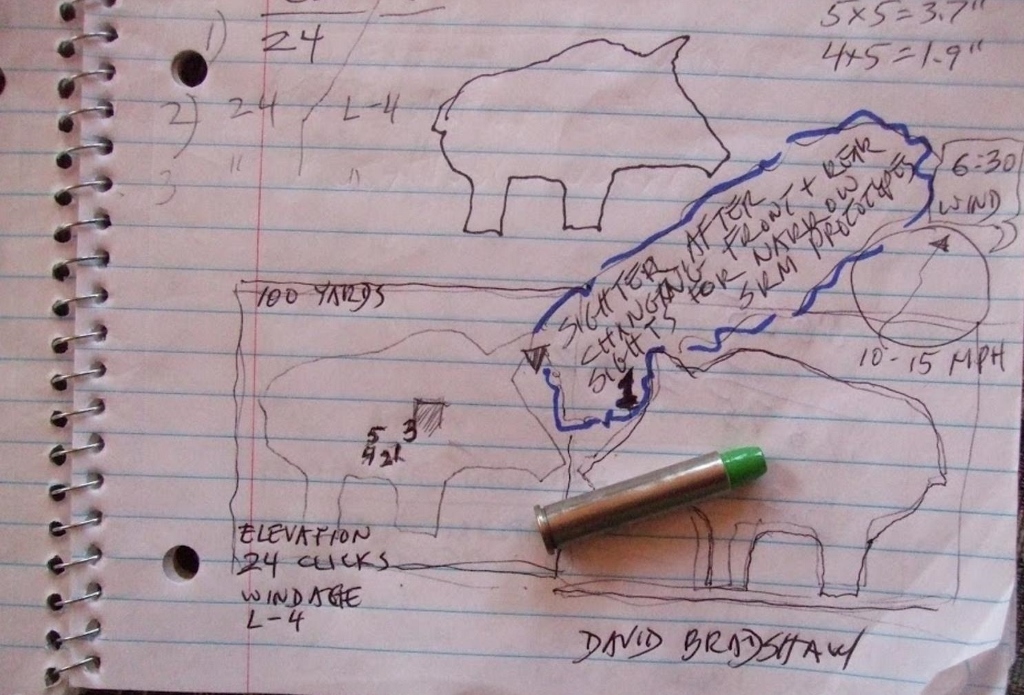 This is the star 2 Dogs talks about, except his one is fusion of combustion & powder coating——not grease. Comes off on your finger.  Easy to swap front sights on the Ruger Maximum Bull 10-1/2”. Clear fingernail polish (evident on barrel) secures sight base and screw. This blade measures .107” wide.  Wind drift, fortunately a very steady breeze. Bradshaw-Martin 194 SWC GC over 18.5/IMR 4227 drifts seven inches @ 100 yards. Cartridge indicates Point of Aim. Ruer sights: front .107”; 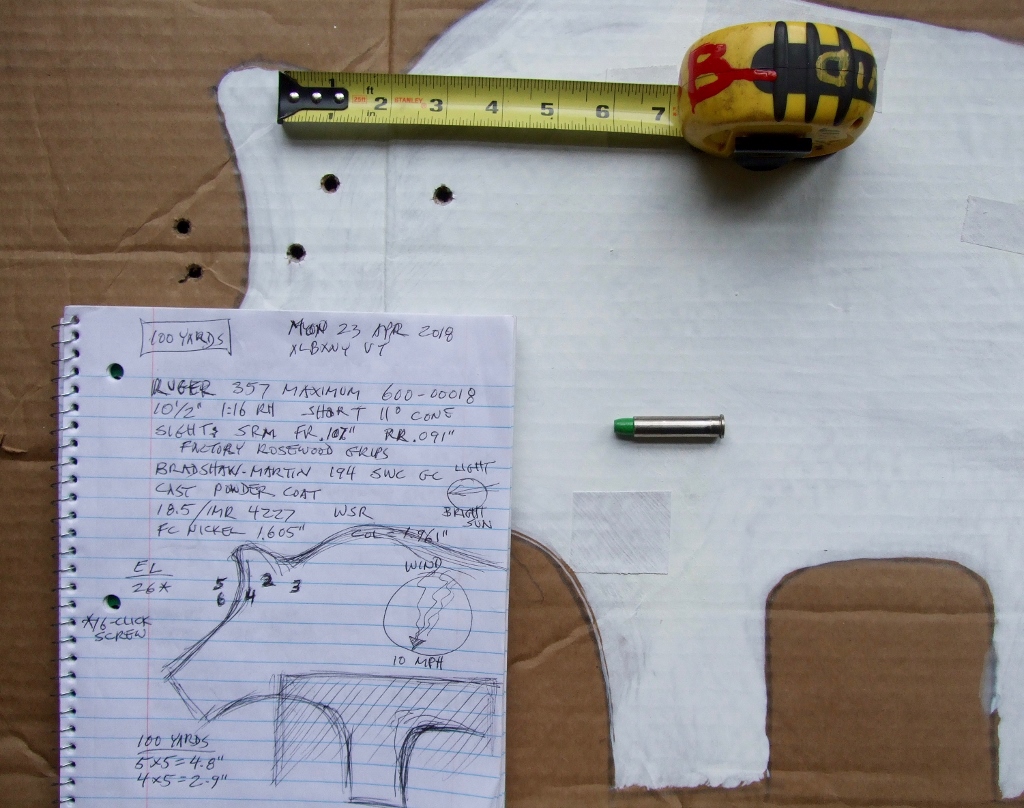 5x5=4.8” @ 100 yards, with 4x5 into 2.9-inches. Front sight centered just above front leg, suggesting 7-inches drift on wind, which shifted without choppiness from 1 o’clock to 3 0’clock. Despite horizontal dispersion, group indicates wind held steady from same direction for these shots. 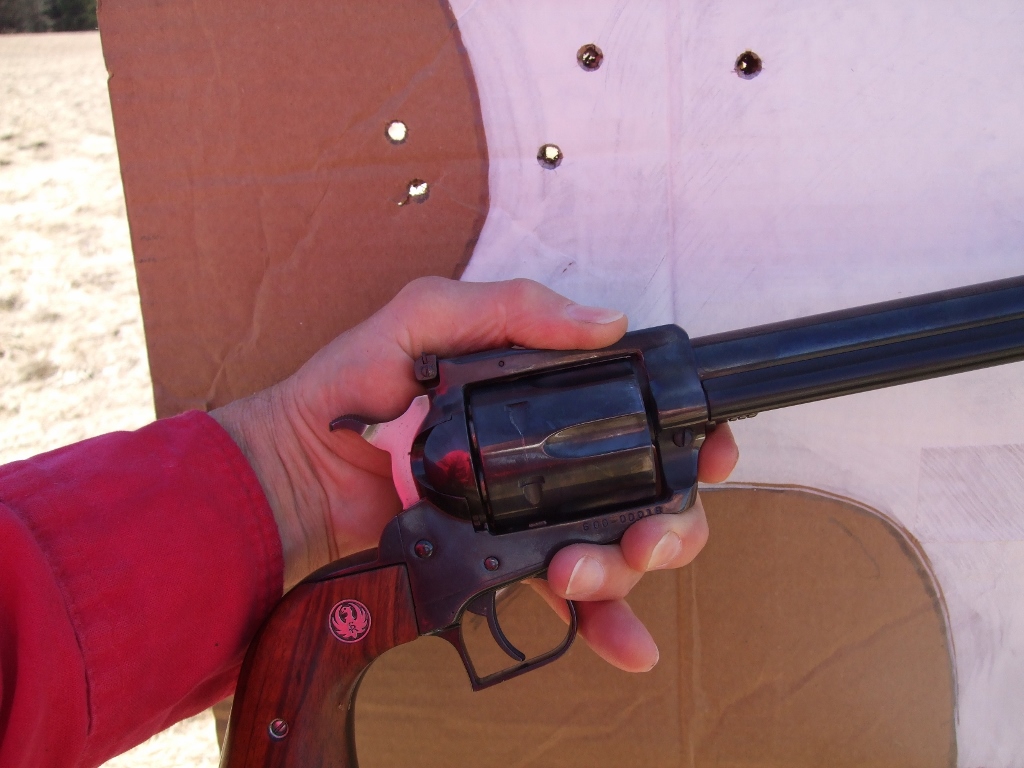 Five rounds of cast powder coat Maximums, ready to go. 1.605-inch case with light roll crimp on front band, still considered deep seating. A heavy roll crimp is unnecessary and is apt to swell brass immediately behind mouth of case. 18.5/IMR 4227, WSR, Sized in Redding carbide .357 Maximum die. Carbide dies tend to leave visible ring at web. Strong neck tension.  Maximum “barrel action” with cylinders. Torn down for cleaning and to tune hammer & trigger. Frame, barrel, cylinders cleaned up quickly, even less fowling than from jacketed bullets. 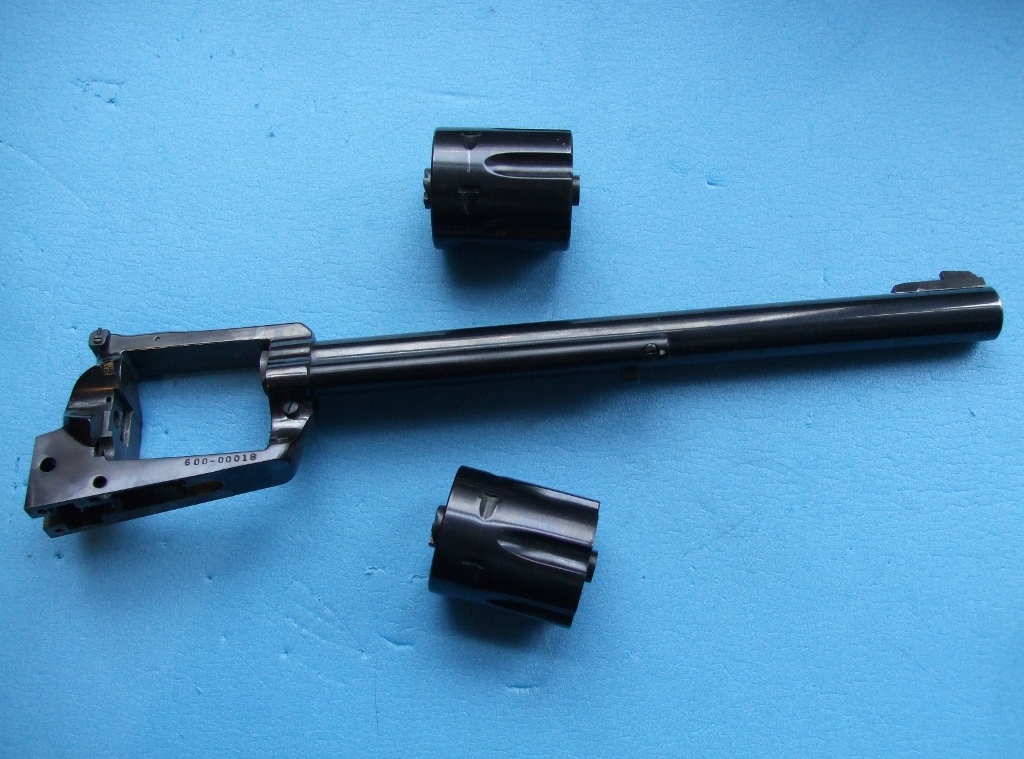 A short, 11-degree forcing cone on Ruger .357 Maximum. Fouling from cast, powder coat Bradshaw-Martin 194 SWC GC, mostly over 18.5/IMR 4227. 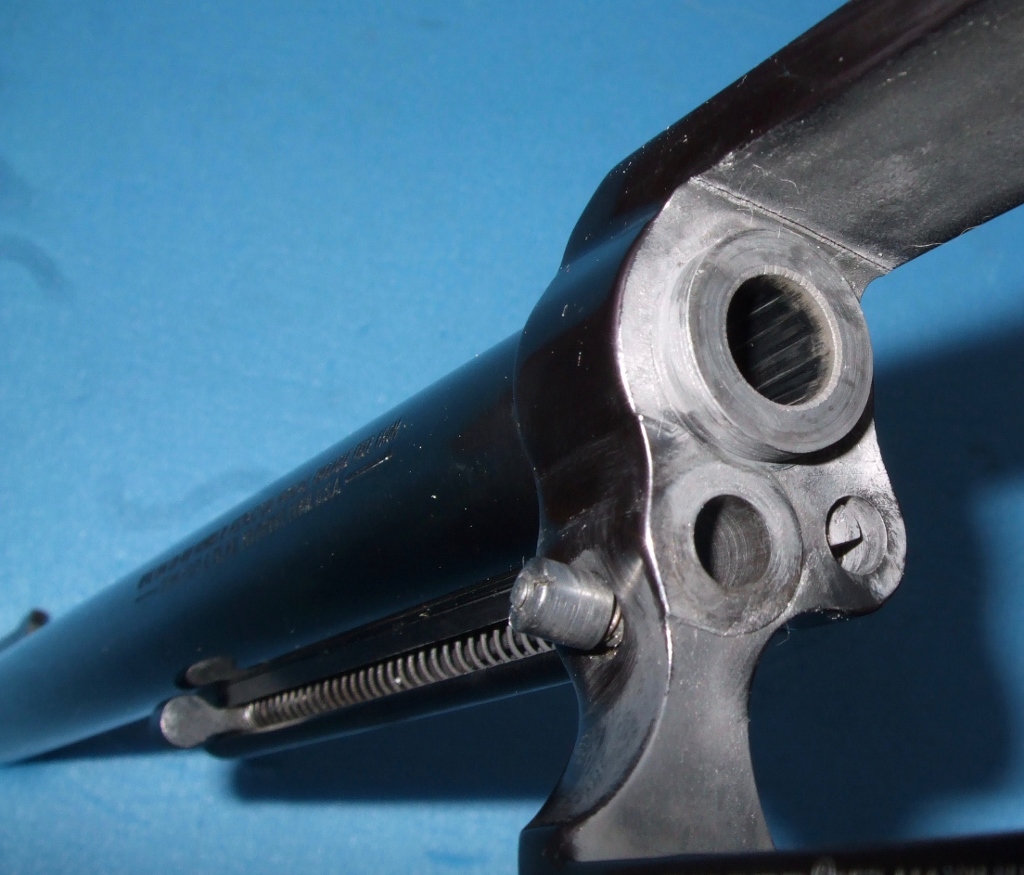 Cuts in back of Maximum frame mate to lugs on the “ears” of gripframe. These cuts in the frame , along with lugs on the “ears” of the gripframe, allow revolver to be test-assembled using only the forward grip frame screw.  Blackhawk Maximum gripframe. Triangular lugs at base of grip frame “ears” index cuts in cylinder frame. Arrangement enhances stability of gripframe to frame. 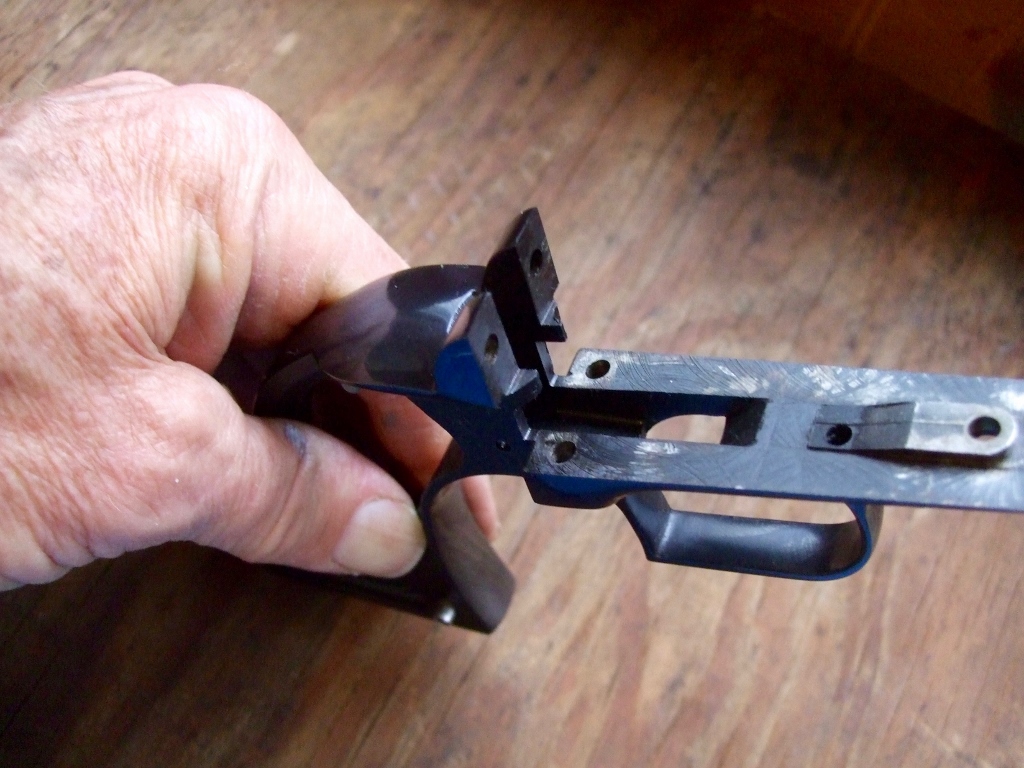 Ruger Maximum used gripframe, hammer & trigger borrowed from Super Blackhawk. All trigger jobs on SRM prototype Maximums were done by Bradshaw, mostly on Ruger’s coffee table. Ruger mechanics in Southport inspected the guns after shooting sessions in New Hampshire. On re-assembly, new lockwork was installed, each requiring a trigger job. David quickly learned to remove his trigger jobs before their return to Southport. Thus, following each trip, David reinstalled his trigger job in each gun to be shot. David kept lockwork from a number of the SRM’s, with one such hammer seen here. Shiny areas indicate metal removal (done in 1981-’82). Flat appearance of large rectangle is an optical illusion; the “trigger ramp" is arced. 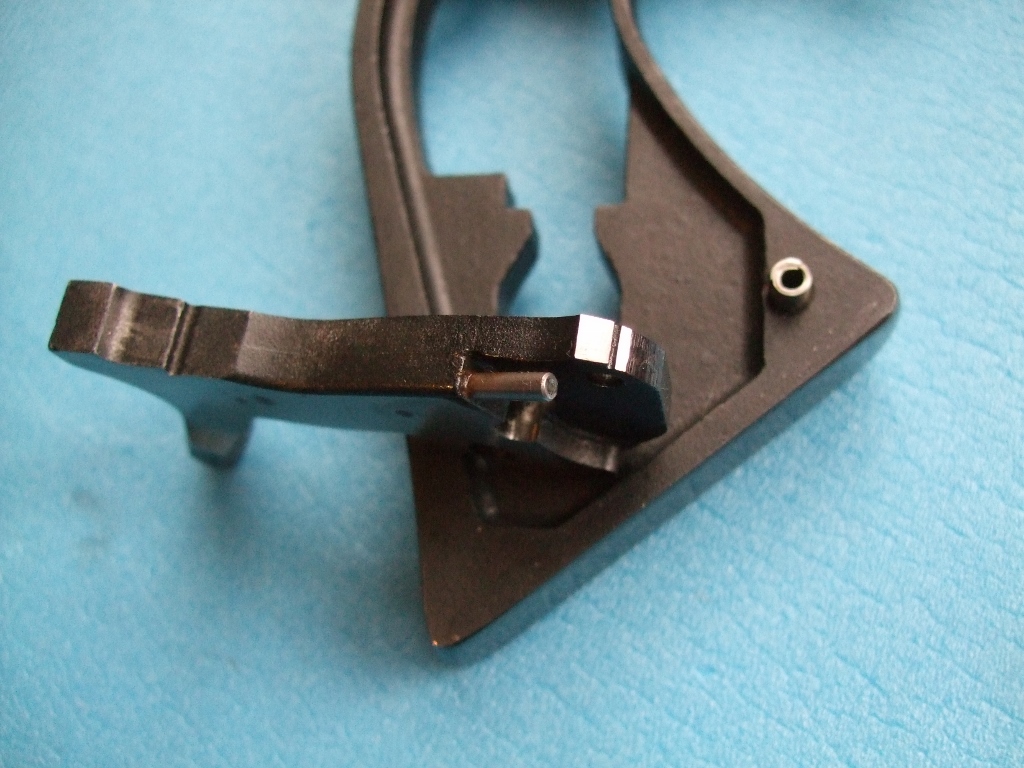 SRM hammer removed from Maximum 600-00018: hammer beginning to “kick” during April 2018 shooting session with Bradshaw-Martin 194 SWC GC. Hammer & trigger each touched up with Eze-Lap fine diamond “stone,” and Spyderco white ceramic “stone.” Note original Ruger coffee table trigger job——done by David with a file. At that time (1981), engagement surface of HAMMER DOG was not touched. 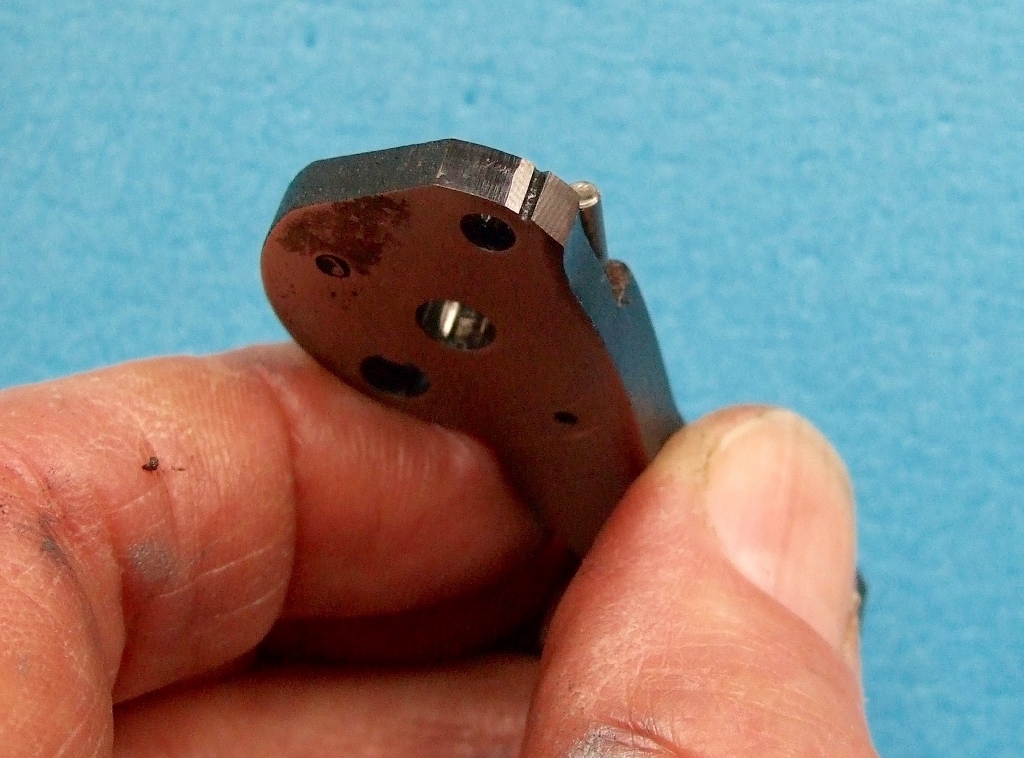 Pawl (left) and transfer bar from first production Maximum assembled. Light polish on ratchet side of pawl as manufactured. As with hammer & trigger, the pawl and transfer bar (along with frame, gripframe, and loading gate) were investment cast in Newport, New Hampshire, shipped to Southport, Connecticut for machining and assembly.  -Lee www.singleactions.com"Chasing perfection five shots at a time" |
|
|
|
Post by Lee Martin on Apr 30, 2018 20:17:29 GMT -5
12.0 of Blue Dot with the 194 gr Bradshaw-Martin SWC:  Using my Lab Radar, velocity was recorded at multiple intervals out to 100 yards: Muzzle = 1,209 fps 25 yards = 1,155 fps 50 yards = 1,112 fps 75 yards = 1,074 fps 100 yards = 1,041 fps Surprisingly linear results. The load was light and I suspect it’ll take 13.0. However, accuracy with Blue Dot at 100 yards was lackluster. Most spreads were in the 7 to 9 inch range. A typical group from Saturday’s session:  This was my best group on the day:  Note: 1) There were no close seconds to the group shown above. This one may have been an outlier...or in other words, luck 2) I only adjusted elevation, leaving windage untouched. On horizontal, the gun hits dead center with my preferred load (18.5 grs of IMR 4227). More work to do, including trials with HS6 and IMR 4198. -Lee www.singleactions.com"Chasing perfection five shots at a time" |
|
|
|
Post by bradshaw on Apr 30, 2018 22:57:54 GMT -5
Smooth as my Maximum operates, it was time for a strip-clean. The revolver had borrowed a hammer & trigger originally tuned for SRM prototypes. The trigger had begun to kick, so it was time for a tune with fine stones to restore the REGRAIN engagement. Don’t know whether the term “regain” came from the Rugers, or another age. REGAIN refers to angles of engagement between hammer and trigger which incline the sear to engage----rather than disengage. It means the sear wants to hold, not let go.
Oil around the hammer plunger was rusty, which may date to manufacture of the part. Blued parts undergo PASSIVATION to neutralize bluing salts. Incomplete passivation causes rust over time. File marks on the hammer date to 1981 and expediency to unlimber the SRM’s and throw lead, with usable triggers.
I’m still playing with the sights, trying to find a combination friendly enough to my eyes to fix a sight picture, and to repeat it. Took a rear blade, handmade at the Lacey Place shop in Southport, and set it in a Ruger steel sight body, found among sights assembled by Ruger, Jr., during SRM development. Yesterday I installed narrow sights----front blade .111-inch; rear notch .065” wide x .060” deep. May have a chance to try them today.
David Bradshaw
|
|
|
|
Post by sixshot on May 1, 2018 0:14:34 GMT -5
Really good stuff! I think everyone is enjoying this very much, I know I am. I do have one question....how come your lackluster groups are everyone else's "wallet braggers"!!!!!! If you guys & the rest of us keep pumping life into the stretch frame 357 Maximum I hope & pray that Lipsey's or someone will see the light & bring it back, it's just too good to not be available as a catalog item. Come on Jason!! I'll take him on an elk or bear hunt if he brings it back.
We got snow & rain today, no shooting for me, bummer!
Dick
|
|
|
|
Post by 2 Dogs on May 1, 2018 9:38:58 GMT -5
Outstanding thread and just excellent shooting and what a collaboration. You guys are clicking together like me and Dick with chopsicks at a Chinese buffet!
I do have one question about the Ruger rear sight. As you are adding elevation (and I realize I might have missed this), is the sight tracking left or right as well as upwards?
|
|
|
|
Post by sixshot on May 1, 2018 9:45:53 GMT -5
Good point Fermin, that's a common problem with any iron sighted gun.
Dick
|
|